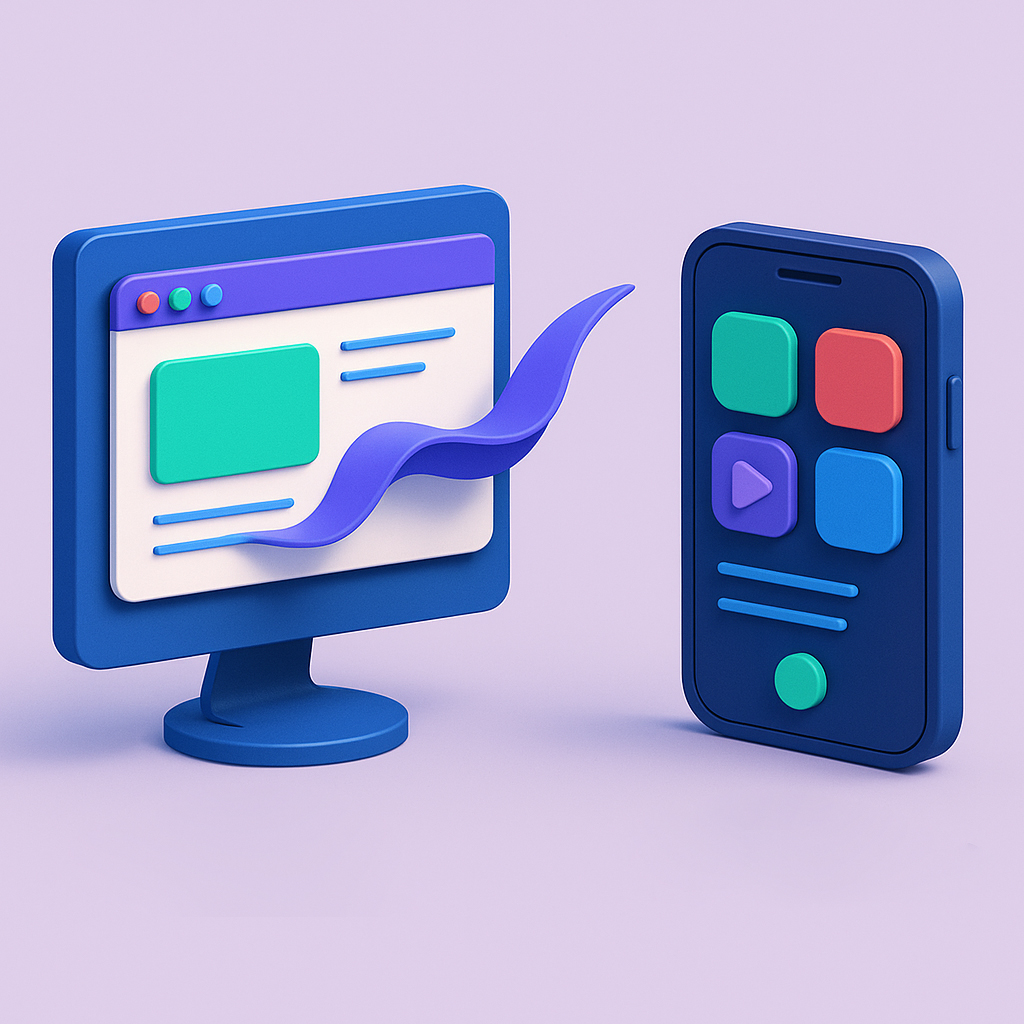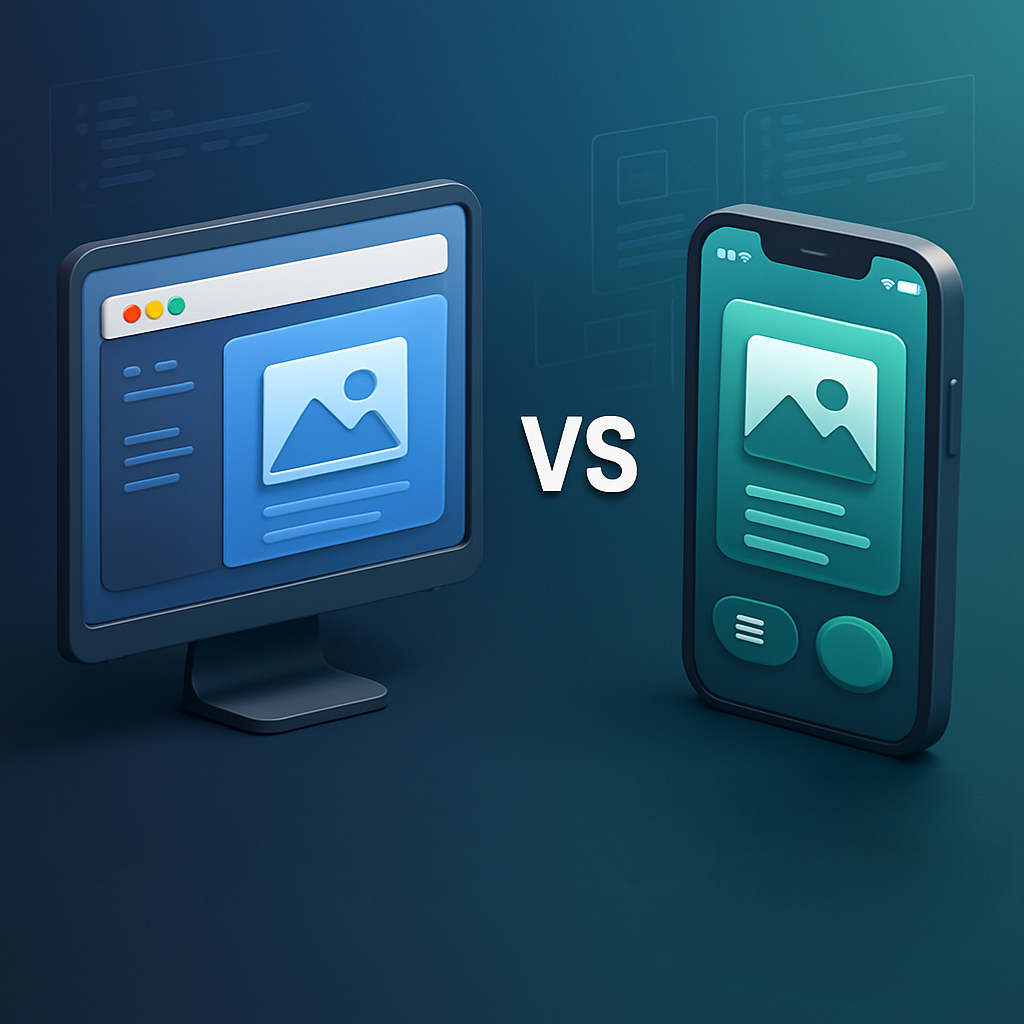打造卓越软件
让我们一起创造非凡。
Lasting Dynamics 提供无与伦比的软件质量。
路易斯-兰伯特
10 月 22, 2025 • 10 min read

The debate between web app vs mobile app has never been more relevant than in 2025. As digital experiences become central to how businesses connect with their audiences, deciding which platform to prioritize is no longer a simple choice. Both web apps and mobile apps offer unique advantages, but they also come with limitations that can significantly impact user experience, development costs, scalability, and long-term growth.
Today’s fast-changing technology landscape makes the decision even more complex. Progressive Web Apps (PWAs) blur the lines between web and mobile, offering a hybrid solution that challenges the traditional app model. At the same time, users are more demanding than ever, expecting speed, convenience, and seamless interaction regardless of the device they use. For startups, choosing the wrong option could mean wasted resources, while for enterprises, it could determine market competitiveness and customer loyalty.
This guide provides a detailed, data-driven comparison of web apps vs mobile apps, highlighting their key differences, advantages, and use cases. Whether you are a product manager evaluating development strategies, an entrepreneur building your first digital product, or an enterprise leader seeking to optimize your digital ecosystem, understanding these distinctions will help you make smarter, future-proof decisions.

A web app is an application that runs in a web browser, accessible via a URL, and built using standard web technologies such as HTML, CSS, and JavaScript. Web apps are platform-independent, meaning they can be accessed from any device with a browser, including desktops, tablets, and smartphones. This universality makes web apps a popular choice for businesses seeking broad reach and easy maintenance.
In contrast, a mobile app is a software application developed specifically for mobile devices, such as smartphones and tablets. Mobile apps are typically downloaded and installed from app stores like Google Play or the Apple App Store. They can be native, built for a specific operating system using languages like Swift or Kotlin, or cross-platform, using frameworks like React Native or Flutter. Mobile apps offer deep integration with device hardware and operating system features, providing a more immersive user experience.
The distinction between web app vs mobile app is not always clear-cut, especially with the rise of progressive web apps (PWAs). PWAs combine the accessibility of web apps with many features of native mobile apps, such as offline access and push notifications. Understanding these core concepts is the first step in determining which solution aligns best with your business goals and user needs.
The primary difference between web apps and mobile apps lies in their development, deployment, and user experience. Web apps are accessed through browsers and do not require installation, making them instantly available to users. Updates are deployed server-side, ensuring all users have access to the latest version without manual downloads. This approach simplifies maintenance and reduces friction for users.
Mobile apps, on the other hand, must be installed from an app store, which can be a barrier for some users. However, once installed, mobile apps can leverage device hardware, offer superior performance, and provide offline functionality. Updates require user action and app store approval, which can lead to version fragmentation if users do not regularly update their apps.
Another key difference is discoverability. Web apps benefit from being indexed by search engines, making them easier to find via organic search. Mobile apps rely on app store optimization and marketing to stand out in crowded marketplaces. Each approach has its own strengths and challenges, which must be weighed carefully when planning your digital strategy.
One of the most significant pain points for businesses is the complexity and cost of development. Building a native mobile app often requires separate codebases for iOS and Android, increasing both initial investment and ongoing maintenance. Web apps, by contrast, use a single codebase that serves all platforms, reducing development time and cost. However, web apps may struggle to deliver the same level of performance and device integration as native mobile apps.
User experience is another major challenge. Mobile apps can provide smoother animations, faster load times, and deeper integration with device features like cameras, GPS, and push notifications. Web apps, while improving rapidly, are still limited by browser capabilities and may not offer the same level of responsiveness or access to hardware. This can impact user satisfaction, especially for applications that require intensive interaction or real-time features.
Discoverability and user retention also present challenges. While web apps are easily accessible via URLs and search engines, they may lack the persistent presence of a mobile app icon on a user’s home screen. Mobile apps benefit from app store exposure and can drive higher engagement through push notifications, but face stiff competition in crowded marketplaces and risk being uninstalled if they do not deliver ongoing value.
Web apps offer several compelling benefits, particularly for businesses seeking broad reach and cost-effective development. With a single codebase, web apps can serve users across all devices and platforms, simplifying maintenance and updates. Instant access via browsers eliminates the need for downloads, reducing friction and making it easier to attract new users. Web apps are also SEO-friendly, allowing content to be indexed by search engines and driving organic traffic to your platform.
Mobile apps, on the other hand, excel in performance and user engagement. By leveraging native device capabilities, mobile apps can deliver fast, responsive experiences and access features like cameras, sensors, and offline storage. Push notifications enable direct communication with users, increasing retention and encouraging repeat usage. For applications that require intensive interaction, real-time updates, or offline functionality, mobile apps are often the preferred choice.
The decision between web app vs mobile app ultimately depends on your business goals, target audience, and required features. Many successful companies adopt a hybrid approach, offering both web and mobile apps to maximize reach and deliver the best possible experience to all users.
Web apps are characterized by their accessibility and flexibility. They are designed to be responsive, adapting to different screen sizes and devices, and can be updated instantly without requiring user intervention. Progressive web apps (PWAs) take this a step further, offering offline access, push notifications, and the ability to be installed on a user’s home screen, blurring the line between web and mobile experiences.
Mobile apps stand out for their deep integration with device hardware and operating system features. They can access sensors, cameras, GPS, and other native components, enabling rich, interactive experiences. Mobile apps also support advanced features like biometric authentication, in-app purchases, and background processing, which are difficult or impossible to achieve with web apps alone.
Both web apps and mobile apps can be designed with user-centric interfaces, but mobile apps often provide a more polished and consistent experience by adhering to platform-specific design guidelines. This attention to detail can make a significant difference in user satisfaction and engagement, especially for applications that require frequent or intensive use.

Web App vs Mobile App: Choose the path that fits your product. Photo by Alvaro Reyes on Unsplash: https://unsplash.com/photos/person-working-on-blue-and-white-paper-on-board-qWwpHwip31M
The technology stack for web apps typically includes HTML5, CSS3, and JavaScript, along with popular frameworks like React, Angular, or Vue.js for the frontend. Backend development can be handled with Node.js, Python (Django, Flask), Ruby on Rails, or PHP (Laravel). Progressive web apps leverage service workers, web app manifests, and tools like Workbox to provide offline capabilities and push notifications. Hosting and deployment are managed through cloud platforms such as AWS, Azure, Google Cloud, Vercel, or Netlify.
Mobile app development can follow two main paths: native or cross-platform. Native iOS apps are built with Swift or Objective-C using Xcode, while native Android apps use Kotlin or Java with Android Studio. Cross-platform frameworks like React Native, Flutter, Xamarin, and Ionic allow developers to write a single codebase that runs on both iOS and Android, reducing development time and cost. Backend services for mobile apps often use Firebase, AWS Amplify, or custom APIs, with CI/CD pipelines managed by tools like Fastlane, Bitrise, or Jenkins.
Choosing the right tech stack depends on your project’s requirements, team expertise, and long-term goals. Web apps offer simplicity and broad reach, while mobile apps provide superior performance and device integration. Many organizations leverage both, using web apps for general access and mobile apps for advanced features and engagement.
让我们一起创造非凡。
Lasting Dynamics 提供无与伦比的软件质量。
Progressive web apps (PWAs) have emerged as a powerful alternative to traditional web and mobile apps, combining the best of both worlds. PWAs are web applications that use modern web technologies to deliver app-like experiences, including offline access, push notifications, and home screen installation. They are accessible via browsers but can be “installed” on a device, providing a more immersive experience than standard web apps.
Native mobile apps, in contrast, are built specifically for a particular operating system and offer the highest level of performance and device integration. They can access all hardware features, run background processes, and provide seamless offline functionality. However, native apps require separate development for each platform, increasing cost and complexity.
The choice between a progressive web app vs native mobile app depends on your priorities. PWAs are ideal for reaching a broad audience quickly and cost-effectively, while native apps are better suited for applications that demand top-tier performance, advanced features, or deep device integration. Many businesses are adopting PWAs to complement their native apps, providing users with flexible access options.
The landscape of web app vs mobile app development is evolving rapidly, driven by new technologies and changing user expectations. Progressive web apps are gaining momentum, offering businesses a cost-effective way to deliver app-like experiences without the overhead of native development. Major brands adopting PWAs have reported significant increases in engagement and conversion rates, making them an attractive option for many organizations.
Cross-platform development frameworks like React Native and Flutter are now the norm, enabling faster deployment and consistent user experiences across iOS and Android. Mobile-first and responsive design are essential, with a great portion of global web traffic comes from mobile devices. Google’s mobile-first indexing further emphasizes the importance of optimizing web apps for mobile users.
Security, privacy, and accessibility are top priorities for both web and mobile apps. Implementing HTTPS, secure authentication, and compliance with regulations like GDPR and CCPA are non-negotiable. User-centric design, performance optimization, and continuous integration/deployment are best practices that ensure your app remains competitive and user-friendly in a crowded marketplace.
Many leading companies around the world have found success by combining the strengths of both web apps and mobile apps. This approach allows them to serve users wherever they are, whether they prefer instant access through a browser or a fully optimized mobile experience on their devices.
Some organizations use mobile apps to deliver maximum performance, offline access, and deeper integration with smartphone features. At the same time, they rely on web apps to provide quick entry points, reduce barriers to use, and reach wider audiences who may not want to download an app.
This flexible strategy shows that there is no single “best” option. Instead, the right choice depends on user needs, market conditions, and business goals. By offering both, companies can boost engagement, improve accessibility, and strengthen customer loyalty across different segments.

Web App vs Mobile App: The choice that defines your product. Photo by Olaf Val on Unsplash: https://unsplash.com/photos/person-holding-black-and-white-ceramic-mug-UTk9cXzYWAg
At Lasting Dynamics, we have supported many clients in choosing the right digital strategy when facing the classic web app vs mobile app dilemma. The decision is rarely straightforward, it depends on factors such as business goals, target audience, available resources, and long-term vision.
In one project, a fast-growing startup approached us unsure whether to invest first in a web app, a mobile app, or both. After analyzing their needs, we recommended starting with a progressive web app (PWA). This option provided them with broad accessibility, instant updates, and compatibility across devices, allowing them to test the market quickly while keeping development costs under control. Interesting, correct? Explore our Clients section to see how Lasting Dynamics empowers businesses worldwide.
This experience reflects how Lasting Dynamics approaches every project: with a strategic, data-driven mindset that balances short-term priorities with long-term growth. By guiding clients step by step, we ensure they invest in solutions that are flexible, sustainable, and aligned with their future goals.
从创意到发布,我们根据您的业务需求量身打造可扩展的软件。
与我们合作,加速您的成长。
Choosing between a web app vs mobile app is no longer a simple technical decision; it is a strategic move that can define the future of your digital presence. Each approach brings unique strengths to the table. Web apps stand out for their accessibility, lower development costs, and ease of updates, making them especially powerful for businesses that want to reach the widest possible audience without the friction of app store downloads.
On the other hand, mobile apps excel at delivering high-performance, feature-rich experiences that fully leverage device capabilities such as cameras, GPS, and push notifications. This deeper integration often leads to stronger user engagement and retention, which is why many companies continue to prioritize mobile-first strategies. Progressive Web Apps (PWAs) and cross-platform frameworks now bridge the gap, offering hybrid solutions that combine the scalability of the web with the immersive feel of native apps.
Ultimately, the most successful organizations view web apps and mobile apps as complementary rather than competing solutions. Making the right choice today will not only improve user satisfaction but also create a strong foundation for growth and innovation in the years ahead.
Ready to make the right choice for your next digital project? 👉 联系 Lasting Dynamics today for expert guidance on web app vs mobile app development. Our team will help you design, build, and launch solutions tailored to your business goals and user needs. Don’t leave your digital strategy to chance, partner with Lasting Dynamics and unlock your project’s full potential!
A web app runs in a browser and is accessible via a URL, while a mobile app is installed from an app store and designed for specific mobile devices. Web apps are platform-independent, whereas mobile apps can leverage device hardware for superior performance.
The best choice depends on your goals, budget, and target audience. Web apps offer broad reach and lower costs, while mobile apps provide better performance and deeper device integration. Many businesses use both to maximize impact.
PWAs combine the accessibility of web apps with features like offline access, push notifications, and home screen installation, offering a near-native experience without requiring app store downloads.
Web apps are generally less expensive to develop and maintain, as a single codebase serves all platforms. Mobile apps require separate development for iOS and Android, increasing costs.
Progressive web apps (PWAs) can provide offline functionality using service workers, but traditional web apps typically require an internet connection. Native mobile apps offer more robust offline capabilities.
将大胆的想法转化为强大的应用。
让我们一起创造出具有影响力的软件。
路易斯-兰伯特
我是一名多媒体设计师、文案和营销专家。我正在积极寻求新的挑战,以挑战自己的技能,实现职业成长。